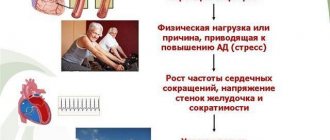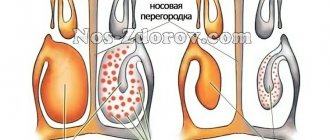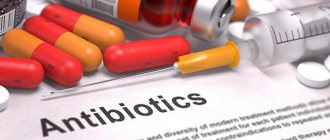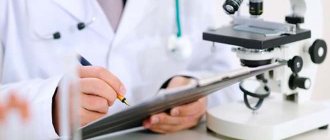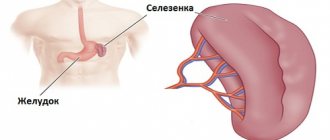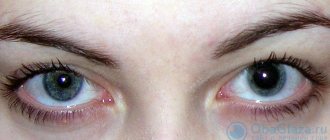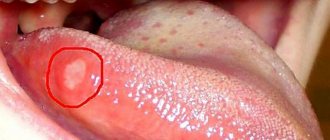Irina Baranova
Cardiologist
Higher education:
Cardiologist
Kuban State Medical University (KubSMU, KubSMA, KubSMI) Level of education - Specialist 1993-1999
Additional education:
“Cardiology”, “Course on magnetic resonance imaging of the cardiovascular system”,
Research Institute of Cardiology named after. A.L. Myasnikova
"Course on functional diagnostics"
NTsSSKh them. A. N. Bakuleva
"Course in Clinical Pharmacology"
Russian Medical Academy of Postgraduate Education
"Emergency Cardiology"
Cantonal Hospital of Geneva, Geneva (Switzerland)
"Therapy course"
Russian State Medical Institute of Roszdrav
Contacts
Cardiomyopathy - what is it? This disease is a generalized name for a group of cardiovascular pathologies that impair the normal functioning of the myocardium (this is the heart muscle that pumps blood), which causes pathological changes throughout the human body.
Cardiomyopathies are diseases of the same type and are characterized by the occurrence of sclerotic and dystrophic disorders in cardiomyocytes (heart cells), but the nature of their origin can be different. In addition, such ailments can be either independent or secondary. It is known that cardiomyopathy often appears against the background of such diseases as vasculitis (widespread inflammation of blood vessels), coronary heart disease (myocardial damage, resulting in insufficient blood flow to the organ), myocarditis (formation of an inflammatory process in the heart muscle), hypertension (impaired activity cardiovascular system), as well as as a result of other pathological conditions (poisoning with toxic, medicinal substances and alcohol).
Cardiomyopathy is most often diagnosed in adults, rarely in adolescents. Medical history states that it occurs in approximately 3 in 1000 people.
Description of the pathology
Many patients, after being diagnosed with cardiomyopathy, do not even know what it is. In cardiology, there are many heart diseases that occur against the background of an inflammatory process, the presence of a malignant neoplasm or coronary artery disease.
Primary cardiomyopathy is not associated with such phenomena. This is a general definition for pathological conditions of the myocardium of uncertain etiology. They are based on the processes of degeneration and sclerosis of cardiac cells and tissues.
Types of primary ILC
Doctors make this diagnosis to a patient under the following circumstances:
- The examination revealed signs of dystrophic damage to the heart muscle.
- After the tests the following were not detected:
- congenital heart abnormalities;
- systemic lesions of the coronary vessels;
- pericarditis;
- hypertension.
heart valve defects;
Cardiomyopathy is a group of cardiac pathologies of idiopathic origin. They are characterized by the presence of severe myocardial damage in the absence of congenital or acquired cardiac anomalies.
Ways to combat pathology
Treatment of primary cardiomyopathy involves, first of all, eliminating the progression of the disease and other concomitant diseases that arise against its background. If acute heart failure is detected in a patient, he is hospitalized and subsequent treatment is carried out in an inpatient setting. If cardiomyopathy has a stable course, then elimination of the disease can be performed on an outpatient basis, but subject to regular examination by a doctor, which should be carried out at least 1-2 times a year.
In order to cure idiopathic (primary) cardiomyopathy, the following medications are used:
- beta blockers and glycosides. Used in case of deterioration in the contractility of the heart muscle and the pumping activity of the organ;
- diuretics. Such drugs help reduce pulmonary and venous congestion;
- antiplatelet agents and anticoagulants. These medications prevent the formation of thrombi (blood clots) in the human vascular system;
- inhibitors. Used to reduce blood pressure;
- antioxidants (substances that neutralize the effects of free radicals) and various vitamin complexes. Provide improvement of metabolic processes in the myocardium;
- antiarrhythmic drugs. These types of drugs correct heart rhythms.
Secondary cardiomyopathies are treated by eliminating the main factors that provoke the development of the underlying pathology.
Methods of traditional treatment of the pathological process
In addition to drug therapy, some traditional medicine can be used to combat heart disease and cardiomyopathy. For example, rosehip in the form of a decoction has a general strengthening effect for the heart, blood vessels and the body as a whole, as it contains many antioxidants.
During the treatment of cardiomyopathy, the patient is allowed to take other herbal drinks, but it is necessary to consult a doctor. These include:
- decoction of flax seeds. This product contains organic acids that have a beneficial effect on heart cells. 1 tbsp. l. dry seeds pour 1 liter of boiling water, cover with a lid and let brew for about 60 minutes, strain. Take 0.5 cups 4 times a day for no longer than 1 month;
- infusion of hawthorn berries, viburnum and calendula flowers. Take 1 tbsp. l. each ingredient and place in a thermos, pour 500 ml of boiling water, leave for 12 hours. Take the infusion 3 times a day, 150 ml, regardless of meals. The course of treatment is at least 1 month;
- motherwort decoction. 50 g of herb is poured into 400 ml of boiling water and allowed to brew for about 1 hour. After this, the broth is filtered through cheesecloth. You need to take this drink 50 ml 4 times a day for 20 days.
Cardiomyopathy is a dangerous disease, the treatment of which must begin immediately.
Why does it arise and how does it develop?
Why does cardiomyopathy occur? Its reasons can be very different. It all depends on what kind of cardiomyopathy it is - primary or secondary. Primary can be congenital, acquired or mixed. Congenital develops during the period of intrauterine development, when abnormalities of the heart cells occur. In this case, an important role is played by:
- heredity;
- gene abnormalities;
- the mother has bad habits;
- stress suffered during pregnancy;
- improper nutrition of a woman during pregnancy.
Causes of pathology
Acquired or mixed cardiomyopathies occur due to:
- pregnancy;
- myocarditis;
- damage from toxic substances;
- hormonal disorders;
- immune pathologies.
Secondary cardiomyopathy develops against the background of certain diseases. Among them:
- Genetic disorders (accumulation of abnormal inclusions between heart cells).
- Presence of tumors.
- Drug, toxic or alcohol poisoning;
Disturbance of metabolic processes in the myocardium. It arises due to:
- menopause;
- excess weight;
- endocrine disorders;
- diseases of the digestive system.
poor nutrition;
Most often, this pathology is observed in adults. But it can also occur in children, especially due to physiological reasons - due to impaired development of heart cells during the period of growth and development.
Secondary cardiomyopathy: causes, symptoms, treatment, cause of death
Secondary cardiomyopathy is a symptomatic heart pathology, the development of which is associated with systemic pathologies of organs and systems. The problem significantly deteriorates a person’s quality of life and requires treatment. In some cases, it can cause complications that are incompatible with life. Therapy consists of eliminating the underlying disease.
What is
All cardiomyopathies are accompanied by dystrophic changes in the heart muscle. This condition is not associated with ischemic disorders, pulmonary and arterial hypertension, heart defects and other cardiac pathologies.
There are primary and secondary cardiomyopathies. The first option is associated with impaired contractility of the heart due to myocardial dystrophy.
The secondary form of the disease is always caused by generalized systemic diseases.
Classification
Taking into account the factors under which the heart muscle was damaged, secondary cardiomyopathies can be:
- Alcoholic. The problem arises when the myocardium is exposed to ethyl alcohol for a long time. This diagnosis is more often given to men suffering from alcohol addiction. This changes the appearance of the heart. It turns yellow.
- Toxic and medicinal. If poisoning with arsenic, cobalt, lithium and other chemical elements occurs, the thickness of the myocardium becomes covered with microscopic tears, which gradually become inflamed.
- Metabolic. This problem is associated with disturbances in metabolic processes. It develops with decreased or increased production of thyroid hormones by the thyroid gland, with a lack or excess of potassium, with glycogenosis, acute deficiency of thiamine and other important components.
- Caused by pathologies of the digestive system. Systemic failures in the digestive organs contribute to disruption of the heart. This occurs with cirrhosis of the liver, impaired absorption in people with pancreatitis, and other conditions.
- Associated with connective tissue pathologies. The development of cardiomyopathy is facilitated by changes that occur with arthrosis, lupus erythematosus, and periarteritis nodosa. They cause necrosis in the microscopic fibers of the heart muscle. Very often the disease follows psoriasis, scleroderma, and dermatomyositis.
- Caused by neuromuscular diseases such as dystrophies and ataxias.
- Viral and infectious. When pathogenic microorganisms, viruses and parasites enter the body, the functions of many systems are disrupted. This creates favorable conditions for the development of various diseases, including cardiomyopathy.
- Related to cancer. This condition develops during carcinomatosis. In this case, unusual substances, such as lymph and other biological fluids, accumulate in the heart muscle. This contributes to the development of dystrophic changes.
- Menopausal. Due to age-related changes, the functional state of the heart muscle deteriorates. The climacteric form of cardiomyopathy is associated with menopause in women.
Reasons for development
Secondary cardiomyopathy is a condition that develops as a complication when hormonal, metabolic and physicochemical changes occur in the body.
A disease can only occur if there is a pathology contributing to it. Secondary cardiomyopathy is not classified as an independent disease.
There are many predisposing factors:
- the heart muscle is damaged when the body is exposed to chemicals or bacterial waste products;
- metabolic disorders and hormonal imbalance;
- insufficient intake of certain beneficial components into the body;
- the presence of pathological processes in the endocrine glands, digestive or neuromuscular systems.
The disease can also occur in newborns with intrauterine malformations.
To determine the course of treatment, you must first identify the underlying problem causing the cardiomyopathy.
Manifestations
The clinical picture of cardiomyopathy is characterized by the appearance of aching pain in the chest in the absence of physical and emotional stress.
The state of health most often returns to normal on its own, so most patients do not pay attention to these signals about impaired contractility of the heart muscle.
With the development of the pathological process, secondary cardiomyopathy is complemented by new symptoms.
What the clinical manifestations will be depends on the underlying disease. Most often with cardiomyopathy:
- feeling dizzy and weak;
- the frequency and rhythm of heart contractions is disrupted;
- legs and face swell;
- Shortness of breath bothers me.
There are also other signs of the disease:
- The alcoholic form is accompanied by increased sweating, sleep disturbances as a result of suffocation, atypical weight loss or weight gain, trembling hands, and yellowing of the sclera of the eyes.
- The metabolic form is manifested by anxiety, hyperhidrosis, dry mouth, painful sensations in the epigastric region, arrhythmia and insomnia. At the same time, attacks of aching and stabbing pain in the heart area are also disturbing.
- Menopausal cardiomyopathy is characterized by the presence of mood swings, feelings of depression, sleep disturbances, dry mucous membranes, chest pain, and abnormal pressure levels in systole and diastole.
Also read: Causes of acute coronary insufficiency and sudden death
It is much more difficult to notice the development of the disease in children. In most cases, they do not feel any symptoms.
Establishing diagnosis
Primary and secondary cardiomyopathies require careful diagnosis. Even if a pronounced clinical picture is present, the problem can only be accurately confirmed after a series of studies.
First, the doctor examines and interviews the patient for complaints. After this, the heart and lungs are listened to, pulse and pressure are measured, and the necessary diagnostic procedures are selected.
Usually prescribed:
- ultrasound examination of the heart and electrocardiography;
- chest x-ray;
- general and biochemical blood tests;
- bicycle ergometry;
- rhythmocardiography.
Using these procedures, you can accurately determine the presence of changes in the heart muscle.
Treatment
There is no specific method that could eliminate secondary cardiomyopathy. Therapeutic measures are selected in order to:
- normalize metabolic processes throughout the body, including the myocardium;
- increase cardiac output;
- prevent further development of the pathological process.
An effective treatment option can only be selected after determining the main source of the problem.
If the disease develops due to disturbances in the functioning of the digestive system, these organs are treated, not the heart.
For pronounced symptoms of cardiomyopathy, medications are prescribed to strengthen the heart muscle, eliminate arrhythmia, and normalize blood flow. This is achieved using:
- anticoagulants;
- cardiac glucosides;
- beta blockers;
- antiarrhythmic drugs;
- means for normalizing hormone production in case of thyrotoxicosis;
- B vitamins;
- drugs to restore metabolic processes in the heart muscle itself;
- products containing potassium and magnesium.
If it is not possible to restore abnormal heart contractions using medications, and the myocardium is weakened and is not able to provide the body with the required amount of blood in one contraction, they resort to installing a pacemaker.
For the entire period of treatment, patients should stop drinking alcohol, especially in the case of alcoholic cardiomyopathy. You also need to avoid smoking, junk food, and stress.
Patients must create a proper diet that can provide the body with all the necessary nutrients, vitamins and minerals.
Consequences and prognosis
It is possible to make a prognosis regarding the course of secondary cardiomyopathy, taking into account the form and stage of development of the underlying disease. Usually, with such an illness, a person’s usual way of life is disrupted. But by giving up bad habits, drawing up the right course of treatment and following the doctor’s recommendations, you can reduce the risk of complications.
The causes of death in secondary cardiomyopathy are thromboembolism, ventricular fibrillation, and cardiovascular failure.
Features of the disease in children and adolescents
Such pathological conditions in childhood are becoming more common. Typically, the development of a secondary form of cardiomyopathy in children occurs:
- if an infectious-inflammatory disease lasts for a long time;
- in case of dysfunction of the autonomic nervous system;
- if there is no favorable environment in the family and environment;
- if the child is malnourished, leads a sedentary lifestyle, and does not follow hygiene rules.
In adults, the disease is easier to detect, but in children it can occur in a latent form for a long time. Therefore, parents are advised to be attentive to the child’s condition and, if it worsens, to conduct an examination. A doctor's consultation is required:
- if the child periodically loses consciousness;
- the area of the nasolabial triangle has turned blue or pale;
- even during minor physical exertion, breathing difficulties occur;
- the child does not want to play, feels apathy and demands that no one bother him;
- Coughing for no reason and sweating increased.
These manifestations are often confused with other diseases, so when they appear, you should immediately visit a pediatrician. He will conduct an examination and select diagnostic techniques to determine the true causes of poor health.
Usually, in order to improve your health, it is enough to normalize the psychological atmosphere, eliminate conflicts in the family, create the right diet and undergo a therapeutic course to eliminate the underlying disease.
Source: https://KardioPuls.ru/bolezni/vtorichnaya-kardiomiopatiya/
Symptoms
Often the symptoms of the disease are hidden. Patients can live a long life without knowing that they have a dangerous pathology. But at the same time it develops and provokes severe complications. The initial stage of cardiomyopathy is easily confused with other diseases. Its characteristic features:
- shortness of breath (with intense physical exertion);
- heartache;
- general weakness;
- dizziness.
Symptoms of the disease
Subsequently, more pronounced and dangerous signs are added to such symptoms. Among them:
- increased blood pressure;
- shortness of breath even with light exertion;
- fatigue, lethargy;
- pallor of the skin, the appearance of a bluish tint;
- swelling (especially of the lower extremities);
- severe chest pain;
- increased heart rate, arrhythmia;
- periodic loss of consciousness.
Symptoms usually depend on the type of cardiomyopathy, as well as the severity of the pathological condition. To determine the disease, you must consult a doctor and undergo a thorough examination.
Classification and characteristics
There are many types of cardiomyopathy. Depending on the causes, the following forms of pathology are distinguished:
- ischemic (occurs due to ischemic damage to heart cells);
- dysmetabolic (associated with metabolic disorders);
- dishormonal (develops due to hormonal imbalances, for example, in women during pregnancy or after menopause);
- genetic;
- alcoholic;
- medicinal or toxic;
- takotsubo or stress (also called broken heart syndrome).
ILC classification
Most doctors, to determine the anatomical and functional changes in the heart muscle, divide cardiomyopathy into the following types:
- dilatational;
- hypertrophic;
- restrictive;
- arrhythmogenic right ventricular.
They have their own developmental features and specific characteristics. Let's look at each of them in more detail. Thus, the dilated or stagnant form most often occurs under the influence of infection, toxic damage, metabolic, hormonal and autoimmune disruptions.
Dilated form
It manifests itself as signs of right and left ventricular failure, pain in the heart that is not relieved by nitrate-containing drugs, rapid heartbeat and arrhythmia. It is characterized by:
- enlargement of the heart chambers;
- hypertrophy;
- deterioration of the contractile function of the heart.
There is also a deformation of the chest, which is called a cardiac hump. With this form, the patient experiences attacks of cardiac asthma, pulmonary edema, ascites, swelling of the neck veins, and enlarged liver.
Hypertrophic cardiomyopathy
The main cause of the hypertrophic form of the disease is an autosomal dominant type of hereditary pathology, which more often occurs in men at different ages. It is characterized by:
- myocardial hypertrophy (can be focal or diffuse, symmetric or asymmetric);
- reduction in the size of the ventricles of the heart (with or without obstruction - a violation of the outflow of blood from the left ventricle).
The specificity of this form is the presence of signs of aortic stenosis in the patient. Among them:
- cardialgia;
- increased heart rate;
- dizziness, weakness, loss of consciousness;
- dyspnea;
- excessive paleness of the skin.
This pathology often causes sudden death of the patient. For example, in athletes during training.
With the restrictive form, there is increased rigidity (hardness, intractability) of the myocardium and a reduced ability of the heart walls to relax. In this case, the left ventricle is poorly filled with blood, which leads to thickening of the walls of the atria. The contractile activity of the myocardium is preserved, the heart is not prone to hypertrophy.
Restrictive cardiomyopathy goes through several stages of development:
- Necrotic. Manifested by the development of coronary lesions and myocarditis.
- Thrombotic. At this stage, the endocardium expands, fibrous deposits appear in the heart cavity, and blood clots appear in the myocardium.
- Fibrotic. In this case, fibrosis of myocardial tissue spreads, and obliterating endarteritis of the coronary arteries occurs.
This form is characterized by the presence of signs of severe circulatory failure. This is manifested by shortness of breath, weakness, swelling, ascites, enlarged liver, swelling of the neck veins.
Restrictive type of pathology
Arrhythmogenic right ventricular cardiomyopathy is a fairly rare pathology that presumably develops as a result of hereditary predisposition, apoptosis, exposure to a viral infection, or chemical poisoning. It is characterized by the replacement of heart cells with fibrous tissue. Against the background of this disease, the following are observed:
- extrasystole or tachycardia;
- ventricular fibrillation;
- atrial fibrillation;
- tachyarrhythmias.
Causes
Cardiomyopathy is the outcome of a number of heart diseases. In fact, this is not a separate disease, but a complex of symptoms that occurs when myocardium is damaged against the background of the following conditions:
- infectious carditis – inflammation of the heart muscle due to viral, fungal or bacterial infections;
- involvement of the heart in the pathological process in autoimmune diseases (systemic lupus erythematosus, rheumatism, etc.);
- arterial hypertension (high blood pressure);
- damage to the heart by toxins - alcohol (alcoholic cardiomyopathy), heavy metals, poisons, medications, drugs;
- chronic ischemic heart disease;
- neuromuscular diseases (Duchenne dystrophy);
- severe variants of protein-energy and vitamin deficiency (severe lack of valuable amino acids, vitamins, minerals) – in case of chronic diseases of the gastrointestinal tract with malabsorption, when following strict and unbalanced diets, in case of forced or voluntary fasting;
- genetic predisposition;
- congenital anomalies of the heart structure.
In some cases, the reasons for the development of the disease are unclear, and then idiopathic dilated cardiomyopathy .
Diagnostic methods
To identify the disease, you should visit a cardiologist. To begin with, he will conduct an examination and interview, and study the patient’s medical record. After this, a thorough examination should be carried out to determine the form and severity of the pathology and possible causes. Often the patient is prescribed:
blood test for hormones;
- blood chemistry;
- ultrasound examination of the heart (determine the size of the heart and its other parameters);
- electrocardiography (records signs of myocardial enlargement, cardiac arrhythmia and conduction disturbances);
- X-ray of the lungs (detect dilatation and enlargement of the myocardium, possible congestion in the lungs);
- echocardiography (determination of myocardial dysfunction);
- ventriculography;
- probing of the heart cavities for morphological examination;
- Magnetic resonance imaging.
Such diagnostics are carried out only in special medical institutions. It is prescribed by the attending physician if there are appropriate indications.
Secondary cardiomyopathy - signs, clinical picture and treatment
Cardiomyopathy is a qualitative change in the heart muscle, in which its functions and structural integrity are impaired. This pathological condition is not a complication of the following diseases:
- coronary heart disease;
- arterial hypertension;
- congenital heart defects;
- acquired defects of the valve apparatus.
The exact cause of primary cardiomyopathies cannot be determined. Secondary lesions of the heart muscle are caused by the pathology of the processes of production and conversion of energy into mechanical work of cardiomyocytes.
articles
- Etiology
- Pathogenesis
- Clinic
- Treatment methods and prognosis
- conclusions
Myocardial dysfunction occurs due to changes in metabolism. Metabolism can be affected by diseases, toxic compounds and external factors. The causes of secondary cardiomyopathy are:
- endocrine diseases;
- infections;
- exogenous intoxication (alcohol);
- accumulation of endogenous toxins (pathology of the kidneys, liver, excess hormones);
- external influence of physical or chemical factors;
- vitamin deficiencies;
- anemia.
Features of certain types of cardiomyopathies
Type of cardiomyopathy Provoking factor Morphological basis Methods for slowing development
| Diabetic | Insulin deficiency and hyperglycemia | Microangiopathy – thickening of the walls of blood vessels supplying the myocardium | Control of blood glucose levels, minimization of risk factors (cessation of smoking, normalization of body weight, adequate physical activity) |
| Thyrotoxic | Excess thyroid hormones | Inflammation and tissue degeneration | Normalization of thyroid function |
| Menopausal | Estrogen deficiency | Reversible myocardial dystrophy | Regular physical activity, hormone replacement therapy |
| Alcoholic | Ethanol | Damage to cell membranes, fatty infiltration of the myocardium, degeneration of blood vessels and cells of the conduction system | Alcohol exclusion |
The general mechanism for the occurrence of cardiac muscle dysfunction for any nature of the provoking factor is as follows:
- Impaired energy supply to cardiomyocytes.
- Operation of regulatory intracellular systems at the highest possible level to ensure the pumping function of the heart.
- Limitation of myocardial reserve capacity. If the use of resources is already turned on at full capacity, then when the load increases there will be no additional output; the reserve has already been exhausted.
- Energy deficiency due to prolonged myocardial hyperfunction.
The heart is adapted to work using its full potential, but without the possibility of returning to a normal rhythm, the reserves of high-energy compounds (“batteries”, energy sources) are depleted.
The decrease in energy production has the following morphological background:
- an increase in the thickness of the capillary wall (it becomes more difficult for oxygen molecules to penetrate the heart tissue);
- reduction in the number of vessels per unit volume of the myocardium (leads to a lack of nutrients);
- dysfunction of mitochondria (cell organelles designed to store energy in the form of molecules - macroergs) due to a lack of enzymes, the synthesis of which requires oxygen;
- excess toxic lipids that destroy the cytoplasmic membranes of cardiomyocytes and trigger apoptosis (cell self-destruction);
- a shift in pH to the acidic side, which leads to a change in the course of processes that regulate the phases of the cardiac cycle (contraction and relaxation).
Clinical symptoms are caused by the disease that provoked the appearance of secondary cardiomyopathy.
Symptoms characteristic of the patient’s pathology include:
- pain in the apex of the heart - downward from the middle of the left clavicle, at the intersection with the fifth intercostal space (in 92% of cases);
- pain behind the sternum (15%);
- expansion of the borders of the heart during percussion examination (the damaged myocardium is stretched);
- muffled first and second sounds over all points of auscultation (the heart muscle is softened);
- arrhythmias (violation of intracardiac control over the activity of the conduction system).
Treatment methods and prognosis
When treating, the following points must be taken into account:
- metabolic disorders in cardiomyocytes are reversible only up to a certain point;
- if normal metabolism in the myocardium is not resumed, heart failure will occur that is resistant to standard therapy (glycosides).
Thus, the success of treatment depends on whether metabolic processes in the myocardium can be normalized in time.
Principles of therapy:
- elimination of the cause (prescription of antibiotics for toxic-infectious processes, replacement or suppressive therapy for endocrine pathology, cessation of alcohol and smoking);
- resumption of adequate energy metabolism: extracellular drugs (hormones, blockers and stimulants of the nervous system);
- intracellular medications (enzymes, cofactors, apoenzymes);
- normalization of the production processes of high-energy molecules (B vitamins, pantothenic and lipoic acids);
- reducing the effect of toxic lipids on cell membranes (antioxidants: tocopheryl acetate, nicotinic acid, vitamin C);
- provision of building materials (essential amino acids with anabolic steroids);
- restoration of ionic balance for adequate contractile activity of the heart muscle (potassium and magnesium supplements).
If cardiomyopathic processes are detected at an early stage, the course of treatment lasts 3-4 weeks. If symptoms persist, it is repeated several times a year.
The prognosis is relatively favorable. The ability to work is limited (physical and nervous overload must be avoided, work with harmful environmental factors must not be allowed). The cause of death in secondary cardiomyopathy can be:
- myocardial infarction;
- rhythm disturbance, up to cardiac arrest;
- pulmonary edema;
- thromboembolic complication.
conclusions
Secondary cardiomyopathies often have a metabolic origin. Disturbances in biochemical processes inside the heart muscle occur as a result of intoxication.
It can be caused by excess hormones, accumulation of toxic compounds (due to insufficient liver and kidney function) or the action of external agents.
Clinical manifestations are often nonspecific.
Characteristically, there is no history of cardiovascular disease.
Treatment is aimed at eliminating the cause and restoring the normal course of biochemical processes in cardiomyocytes.
The following sources of information were used to prepare the material.
Source: https://cardiograf.com/bolezni/porazhenie-myshtsy/vtorichnaya-kardiomiopatiya-prichina-smerti.html
Treatment options
Cardiomyopathy is quite difficult to treat. It is important that the patient follows all the doctor’s instructions. There are several methods of therapy.
Drug therapy
This is treatment using special medications. The following are often prescribed for this pathology:
beta-blockers (Atenolol, Bisoprolol) help improve cardiac function and reduce its need for oxygen;
- anticoagulants (reduce blood clotting) to prevent the development of thrombosis (Heparin, Warfarin);
- drugs that lower blood pressure (ACE inhibitors - Captopril and analogues);
- antioxidants (Carvedilol);
- diuretics (Furasemide) to reduce swelling and lower blood pressure.
Any medications should be taken only as prescribed by a doctor. Self-medication can have a detrimental effect on health or even lead to death.
Surgical intervention
If medications do not have the desired effect and the patient gets worse, surgical treatment may be used. In this case, there are such methods:
- implantation of a pacemaker (for heart rhythm disturbances);
- defibrillator implantation;
- donor heart transplant.
The latter procedure is a very complex and dangerous operation. It is carried out if other methods do not help and the patient dies.
Prevention of complications
When cardiomyopathy occurs in a patient, the risk of negative complications increases. To avoid them, you should follow these recommendations:
- lead a healthy lifestyle;
- avoid excessive stress on the heart;
- avoid stress and negative emotions;
- stop smoking, do not abuse alcoholic beverages;
- Healthy food;
- maintain a sleep and rest schedule.
Prevention of cardiovascular diseases
If the pathology is secondary, that is, it arose against the background of a particular disease, then the patient should constantly monitor his health. He must also undergo treatment and follow the doctor’s instructions.
Features of secondary cardiomyopathy
Today, cardiac pathologies are becoming more common. The way and pace of life undoubtedly affects the human body, which can lead to disorders of the cardiovascular system.
What is secondary cardiomyopathy?
Secondary cardiomyopathy or myocardiopathy (classification - ICD 10, abbreviated as VCMP) are functional and structural changes in the tissues of the heart that appear in various diseases and pathological conditions.
In medical practice, there are a number of types of cardiomyopathy initiated by dystrophic transformations of the myocardium. They differ according to their etiology and symptomatic picture, but have the same properties, which include: lack of cardiac muscle defects due to ischemic heart disease, defects in the construction and functioning of the heart valves, as well as pulmonary and arterial hypertension.
The prognosis is determined by the course of the initial disease and the development of cardiac pathologies.
According to the types of myocardial damage, in our time the corresponding types of this disease are emphasized:
- hypertrophic;
- dilatational;
- restrictive.
VCM of mixed origin is often diagnosed.
Cardiomyopathy (CM) can be primary or secondary. VCMP is combined into a broad category of heterogeneous cardiopathologies, the prerequisites of which, in turn, are associated with generalized systemic diseases of organs and their concepts, painful conditions.
There is also a small risk of developing peripartum cardiomyopathy. The disease occurs in healthy women who have no heart-related pathologies. This happens after childbirth. Left ventricular systolic dysfunction appears.
Causes
Such a disease can be caused by a number of other ailments, which, in turn, are similar in symptoms, but differ in their etiology.
The main reasons include diseases such as:
- uremia;
- pancreatitis;
- metabolic disease;
- infections;
- myopathy;
- malabsorption syndrome;
- alcohol intoxication;
- myasthenia gravis;
- toxic-infectious collapse;
- endocrinopathy;
- cirrhosis of the liver.
Myocardial defects are distinguished by a number of different classifications of VCM. Their definition plays a significant role in the selection of appropriate therapeutic measures aimed at preventing the problem:
- The toxic alcoholic form is caused by general intoxication of the entire body. With constant drinking of alcohol, VCMP appears. In this case, the patient develops fatty degeneration, which causes the heart tissue to turn yellow. Most often, this form of VCMP is detected in men over 30 years of age.
- The effect of toxic and medicinal substances on the body. The consequence of the disease can be poisoning with pesticides, which, in turn, causes microinfarctions.
- For metabolic pathologies. Any metabolic disorder in the myocardium can cause complications. These include: hyperthyroidism, glycogenesis, even a banal lack of vitamins in the body.
- Pathologies of the digestive organs. It can be caused by cirrhosis of the liver, pancreatitis and any other diseases in this area.
- Connective tissue pathologies. These include: rheumatoid arthritis, psoriasis.
General symptoms
Shortness of breath and a feeling of lack of air usually appears during intense physical exertion. It is noted:
- chest pain, usually aching, it is long-lasting;
- increased drowsiness;
- chronic fatigue syndrome;
- sudden fainting;
- sleep disturbance;
- arrhythmia;
- high blood pressure;
- feeling of tightness.
Cardiomyopathy and cardiopathy in children and adolescents
Cardiopathy differs from VCMP in that the process is preventable. For the disease, treatment is quite difficult, and only temporarily alleviates the patient’s condition. Constant relapses are observed throughout his life. In a child, such a disease can be either hereditary or acquired.
To date, doctors cannot identify the exact cause of this disease in children.
Causes of the disease
The reasons for the development of the disease may be as follows:
- if the mother drank alcohol during pregnancy and lactation;
- various kidney lesions;
- food poisoning;
- diabetes;
- stress;
- systemic diseases.
Unlike adults, pathology in children cannot be identified immediately. Usually the child has mild or no symptoms, so most often the diagnosis of VCM is made during a general examination.
Diagnostics
Propaedeutics of cardiovascular diseases is carried out by a cardiologist.
The disease can be determined using a number of studies. These include: biochemical, chest x-ray, rhythmocardiography and echography. An electrocardiogram may show flattening of the T waves.
EchoCG information plays an important role, characterizing myocardial dysfunction and hypertrophy, its explicitness and the main pathophysiological mechanism.
It is permissible to carry out an invasive examination - ventriculography. MRI and MSCT are considered the most advanced methods for visualizing absolutely all departments.
The study of the cavities of the heart makes it possible to isolate cardiac biopsy specimens for the purpose of morphological study.
Forecast
Secondary cardiomyopathy is one of the most complex diseases associated with the cardiovascular system. The pathology has a very high mortality rate, regardless of the age of the patient. The course of her illness is due to constant pressure surges, arrhythmia and the possibility of blood clots.
With effective therapy, survival rate in the first five years is 30%.
Of course, transplantation will be one of the most effective methods of treatment, but only if it has a favorable outcome and if a suitable donor is available.
Cause of death
Secondary cardiomyopathy can cause serious pathologies, which, in turn, worsen the patient's condition and often cause death.
Such ailments include:
- heart failure;
- myocardial infarction;
- blood clot formation;
- pulmonary edema;
- severe arrhythmia.
Even with highly qualified care and good therapy, people with secondary cardiomyopathy live on average from 4 to 8 years. It is important to monitor the patient’s condition and undergo examination on time. The quality of treatment significantly affects life expectancy. Of course, you can resort to transplantation, but in this case there is a huge risk, because not all operations are successful.
Source: https://MirKardio.ru/bolezni/porazhenie/vtorichnaya-kardiomiopatiya.html

